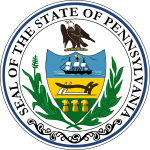| |||||||||||||||||||||||||
All 13 Pennsylvania seats to the United States House of Representatives | |||||||||||||||||||||||||
|---|---|---|---|---|---|---|---|---|---|---|---|---|---|---|---|---|---|---|---|---|---|---|---|---|---|
| |||||||||||||||||||||||||
An election to the United States House of Representatives was held in Pennsylvania on October 9, 1792, for the 3rd Congress.
Background
Eight representatives, 4 Pro-Administration and 4 Anti-Administration, had been elected in the previous election. In the previous election, Pennsylvania had been divided into 8 districts. Five additional seats had been apportioned to Pennsylvania after the 1790 census. All 13 seats were elected at-large, an attempt by the Pro-Administration-majority legislature of Pennsylvania to prevent the election of Anti-Administration Representatives. This backfired and an 8-5 Anti-Administration majority was elected.
Election results
All 8 incumbents ran for re-election. Seven were re-elected. There were a total of 20 candidates running for the 13 seats, 11 Anti-Administration and 9 Pro-Administration (two of the Anti-Administration candidates ran on a dual ticket but are listed here as Anti-Administration)
| Anti-Administration | Pro-Administration | ||||
|---|---|---|---|---|---|
| William Findley (I) | 33,158 | 8.21% | John W. Kittera (I) | 29,835 | 7.39% |
| Frederick Muhlenberg (I) | 32,341 | 8.01% | Thomas Hartley (I) | 28,493 | 7.06% |
| Daniel Hiester (I) | 32,147 | 7.96% | Thomas Fitzsimons (I) | 17,997 | 4.46% |
| William Irvine | 30,968 | 7.67% | James Armstrong | 17,312 | 4.29% |
| Peter Muhlenberg | 21,784 | 5.40% | Thomas Scott | 16,657 | 4.13% |
| Andrew Gregg (I) | 17,372 | 4.30% | Samuel Sitgreaves | 15,588 | 3.86% |
| William Montgomery | 17,019 | 4.22% | William Bingham | 14,482 | 3.59% |
| John Smilie | 16,754 | 4.15% | Henry Wynkoop | 14,348 | 3.55% |
| Jonathan D. Sergeant | 15,096 | 3.74% | Israel Jacobs (I) | 2,626 | 0.65% |
| John Barclay | 14,953 | 3.70% | |||
| Charles Thomson | 14,874 | 3.68% | |||
This was the last year in which Pennsylvania would elect all of its representatives at-large. In the following election, Pennsylvania would be divided up into 12 districts (including one plural district). At various times between 1873 and 1945, between 1 and 4 of Pennsylvania's Representatives were elected at-large, with the rest being elected from single-member districts.
References
- Electoral data and information on districts are from the Wilkes University Elections Statistics Project
